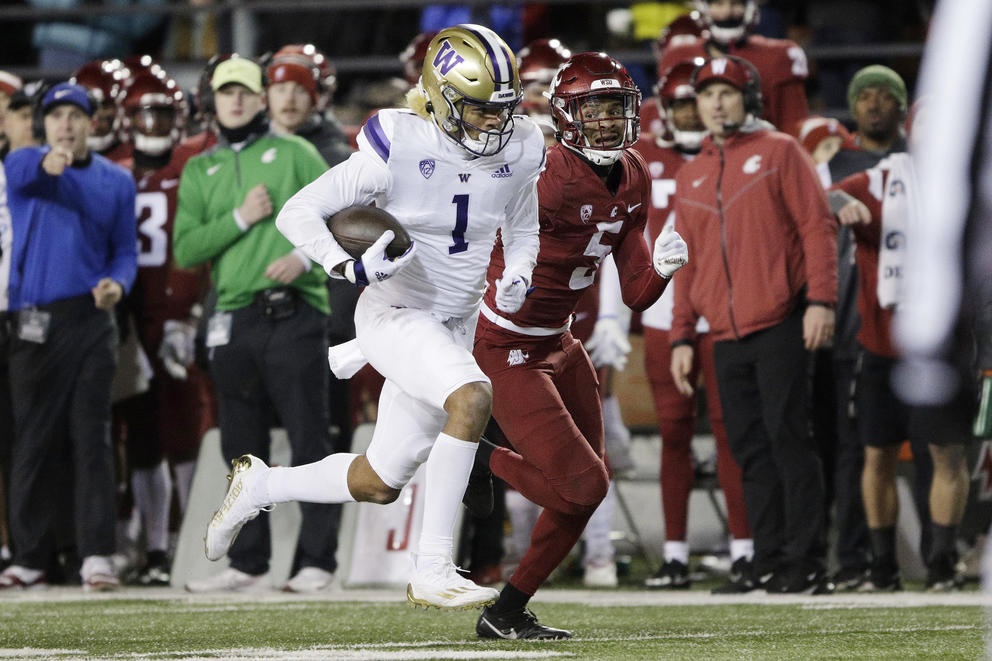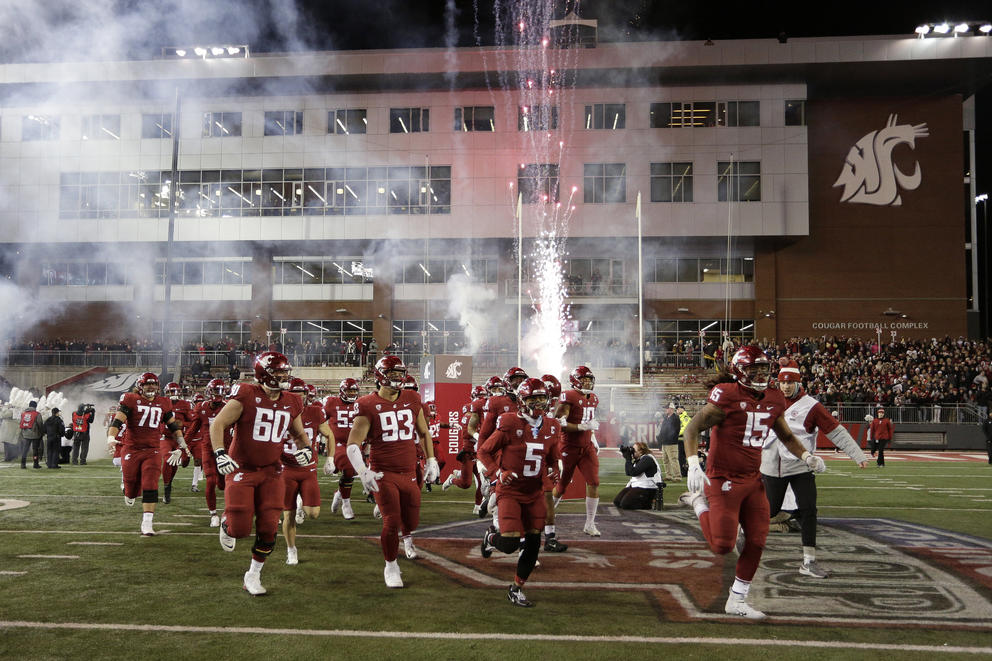The deficit has not come up as Washington State searches for a new home, Weiler said. “There’s a sense of urgency to find the best location for Washington State,” he said, since the upcoming season is the last for the old Pac-12.
Money is a major driver of college sports. Lack of sufficient television money is the main reason the Pac-12 broke up, as eight of the 12 schools decided they could make more playing in another conference.
Washington, Oregon, UCLA and Southern California are moving to the Midwest-dominated Big Ten, where they figure to eventually double their annual share of television revenue. Arizona, Arizona State, Utah and Colorado are moving to the Big 12, where they stand to make millions more each year in the association of teams from Texas, Oklahoma and other states.
Left behind are Washington State and Oregon State, which both play in small markets, along with Stanford and California. Those schools are likely to either join other conferences, such as the Mountain West, or try to lure some other teams and rebuild something out of the remnants of the Pac-12.
Economics of college sports
Either way, the Cougars face a longer road to financial solvency than if the Pac-12 had stayed together.
College sports isn’t cheap. Washington State, one of the thriftier programs amid the so-called power-conference teams, will spend more than $84 million on athletics in fiscal 2024. Other schools spend far more.
There’s a hierarchy in top-level college sports. About 60 of the top programs – including the Cougars – are lumped together in five power conferences, which make the most money. Another 60 or so teams are in lesser conferences that produce far less in television revenue.
As an example, teams in the Pac-12 in recent years got around $20 million each in annual television revenue. Teams in the Big Ten, the Big 12, the SEC or the ACC made far more.
That’s why UCLA and Southern California announced months ago that they were jumping to the Big Ten.
Most of these TV dollars go to the schools with the top football and basketball programs. But the athletic budget obviously includes more than just money to support those teams. Big sports schools have big sports programs, with teams competing with their conference rivals in everything from soccer to softball and gymnastics.
Schools fill in their athletic dollars by selling tickets, attracting fan and alumni donations and charging student fees. The money pays for coaches, athletic scholarships, support staff, facilities, equipment, uniforms and travel.
Even after UCLA and Southern California defected, leaders of the Pac-12 thought they had saved the conference when Commissioner George Kliavkoff last week announced he had reached a new television deal with Apple.
Washington State President KIrk Schulz said on Monday he was “shocked” when Washington and Oregon bailed, essentially sealing the doom of the Pac-12.
Schulz said he remains in contact with the leaders of the three other remaining Pac-12 teams to find a common solution.
Cougar history
Washington State has been a member of the Pac-12 or its predecessor conferences since 1917. It’s a big point of pride in tiny Pullman that the Cougars played in a prestigious conference.
Thousands of people poured into the small town on football game days, filling every hotel room for miles around.
To play at that level cost a lot of money, and the Cougars this past decade were spending more than they were earning.
The problems started around 2010, when former Athletic Director Bill Moos and the late WSU President Elson S. Floyd decided that bigger investments in football were needed for the Cougars to remain a power-conference team.
Expecting a huge bump in Pac-12 media revenue from a new television deal, WSU spent $65 million to improve Martin Stadium and $61 million on a Football Operations Building. They hired a big-name coach, Mike Leach, for $3 million a year.
The investments worked. The football team improved, attendance increased and the Cougars went to six bowl games in eight years under Leach. The Cougars went 11-2 in 2018, the most wins in program history, and beat Iowa State in the Alamo Bowl.
But the Pac-12 media deal fell far short of the annual payments expected by each school, and debts piled up. Administrators started spending down the school’s financial reserves and making cuts in other places to keep athletics afloat. Money from housing, food services, parking and other revenue generators was diverted to sports.
The debt reached more than $100 million a few years ago, and Schulz said enough. Athletics was ordered to balance its annual budget and create a plan to pay off the accumulated debt.
For a time it worked. Washington State had a balanced budget for fiscal 2022, although the earlier debt remained.
But the financial picture soured in fiscal 2023, mostly because of even-lower-than-expected revenue from the Pac-12 and other revenue sources such as student sports passes, as well as higher costs. Athletics posted an $11.5 million deficit for fiscal 2023, which Schulz blamed on “multiple unforeseen challenges” such as inflation.
What's up next?
As a result, WSU athletics has instituted a hiring freeze and suspended non-essential travel. Weiler said the university refinanced the athletics debt during the pandemic when interest rates were low.
“We are back on a path of breaking even on the athletic budget on an annual basis,” Weiler said.
The recent turmoil has created sour feelings among the former Pac-12 teams.
President Schulz said he and Athletic Director Pat Chun have reached out to colleagues across the country looking for a suitable home for WSU sports.
“I know many of you are angry and upset by the situation WSU finds itself in,” Schulz said this week. “And it is tempting to lash out.”
“College athletics is at its worst with this realignment stuff,” Schulz told ESPN on Wednesday. “Everybody is truly looking out for themselves.”
Schulz told ESPN that Washington State might lose 40 percent of its athletic funding because of the demise of the Pac-12, and may have to raise student fees and lean more heavily on donations. But he vowed the school will not cut sports programs.
Chun said Washington State intends to remain a Power 5 program.
“Our performance indicates that we’re a Power 5 school,” Chun told reporters on Wednesday. “We’re going to do our best to continue to compete at that level.”
The WSU Board of Regents announced Thursday they would be holding a special meeting on Friday, Aug. 11, to discuss “present, pending or potential litigation” in a private session with the university’s lawyers. But the meeting announcement didn’t say if the litigation involved athletics.
What happens to the Apple Cup?
The future of the storied Apple Cup game between Washington and Washington State is in question.
Gov. Jay Inslee, a UW alum, has said he hopes the rivalry game continues, and University of Washington officials have said they are open to the idea.
Chun said that would happen only if the game continued to rotate between Seattle and Pullman. “I don’t see how not playing the Apple Cup in Pullman would ever be a good decision for Washington State,” Chun said.
Washington State football coach Jake Dickert sounded a positive note after a recent practice. Cougar football, which dates to the 1890s, will continue, he said.
“WAZZU will find its way,” Dickert said. “We have for 100 some years and we will again.”




